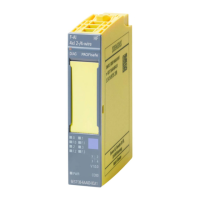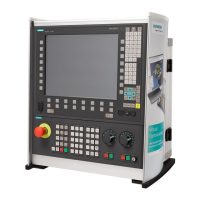Programming of Traversing Blocks 04.97
Behaviour in case of flying block change:
➂➁
➀
MM
M
V
t t t
t
a
a
a
a
a
a
a
a
a
a
a
a
a
a
a
a
a
a
a
a
a
a
a
a
a
a
a
t
a
a
a
a
a
a
a
a
a
a
a
a
a
a
a
a
a
a
a
a
a
a
a
a
a
a
a
a
a
a
a
a
a
a
a
a
a
a
a
t
a
a
a
a
a
a
a
a
a
a
a
a
a
a
a
a
a
a
a
a
a
a
a
a
a
a
a
a
a
a
a
a
a
a
a
a
a
a
a
a
a
a
a
a
a
a
a
a
a
a
a
➀
The output of M-functions is completed before the braking point for the block position is
reached. Thus, a block change without speed reduction can be carried out.
➁
The output of M-functions has not yet been completed at the braking point. The axis starts
to brake. If the output of M-functions is completed during braking, the block is changed
and the axis begins to accelerate.
➂
The axis comes to a standstill. The next block is not executed before the output of
M-functions is completed.
4.11.6.2 Output of M-functions before positioning
The output of M-functions takes place when the execution of the traversing block is enabled.
The traversing movement takes place after the M-output.
Programming:
N10 G76 X100.000 M1=9
N20 X200.000
N30 X300.000 M1=10
N10 N20 N30
V
x
M
t
t
M9
Moment of execution
enable for the next
traversing block
M10
N10: Upon start, M9 is output, then the traversing movement takes place.
N20: The block change N10 ➯ N20 is flying.
N30: As the type of output is "before positioning", first M10 is output and then the
traversing movement of N30 takes place.
The utilization of G60 (exact stop) or G66/G67 (loop-over window 1/2) influences the execution
enable of the traversing block and, therefore, the M-output.
4 – 32 ©
Siemens AG 1997 All Rights Reserved 6ZB5 440-0VU02
WF 723 C (Programming Guide)

